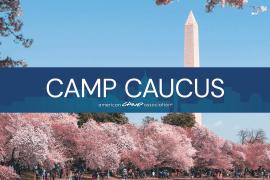According to numerous scientific reports, it’s almost certain that 2023 will be the hottest year on record. And while debates around climate science may still cause controversy in some circles, what is far less controversial among the camp community is this:
We’re going to have to adjust our expectations and assumptions about what camp infrastructure should look like.
Extreme Heat Impacts Health, Safety, and Behavior
Not only have heatwaves become more frequent and intense in the past few decades, but they have also increased in terms of their duration — meaning camps are having to plan for the greater likelihood of extreme temperatures that last for many days, or even weeks, at a time. While the idea of air-conditioned cabins may once have felt antithetical to many camps, there is now a growing realization that relief from extreme heat is not only an important health issue, but it can also impact behavior management and staff retention too. (Behavioral scientists have long documented a link between higher temperatures and irritability, hostility, and even crime.)
Alongside protection from heat, air conditioning (AC) is a potentially important factor in another aspect of climate mitigation — and that’s air filtration. As devastating Canadian wildfires sent air quality plummeting across the continent this past year, regions that have usually been relatively immune from wildfire were suddenly faced with severe, and potentially even life-threatening, smoke.
Air Filtration in Face of Wildfire Smoke
While day camps and other organizations in more urban settings may have the option of temporarily relocating to partner organizations, overnight camps in rural areas rarely have that option. So adding air-conditioned space provides greater flexibility for when it’s unsafe to be outdoors. At some camps in California, leadership have determined that this is a threat that is unlikely to go away in their region, so they have gone a step further. Not only is their dining hall air-conditioned, but they have retrofitted it to include a charcoal-based air filter—so it can serve as a safe refuge for all campers when wildfire smoke gets really out of hand.
That said, there are many things to consider before a camp decides to add air-conditioned space. These include:
- Cost: Not only will AC cost money to install, but it will also increase energy bills over time.
- Suitability: For some camps, older buildings may be poorly suited for air conditioning — meaning units do little to ensure comfort while still adding cost.
- Purpose: It’s important for camps to think through their goals. Is the intent to create comfortable spaces for all campers . . . by adding air conditioning to all cabins, for example? Or is it simply to ensure there is some air-conditioned space to retreat to when extreme spikes in temperature happen?
- Insurability: Adding air conditioning doesn’t only add operating costs. It also increases the cost to rebuild a structure, in the event of a loss. (And that means it may impact insurance premiums.) And the likelihood of property loss far from a trivial concern in an age where rising temperatures are also creating an increased risk of wildfire and other extreme weather events.
- Alternatives: Air conditioning, of course, is not the only way to mitigate for extreme heat. Some camps in Florida, for example, have been experimenting with adding permanent outdoor shade structures, fans, or misters (or a combination of all three) so that campers and staff can get some respite from the sun, without necessarily retreating indoors.
There’s a reason that the term "global warming" has given way to "climate change" — and that’s because higher temperatures are by no means the only consequence of a destabilized global climate.
Tree Management Revisited
Alongside heatwaves, camps are also having to deal with an increased threat of storms, high winds, and flooding — each of which can have dangerous and hard to predict consequences. Camps across the New England region, for example, have been grappling with unprecedented levels of rainfall this summer. And that rainfall has led to soil erosion, and a growing threat from apparently healthy trees toppling over due to saturated ground. As a result, we’ve heard from several camps who are pursuing a far more aggressive program of tree management than in past years, removing trees from around buildings and other gathering places.
Of course, chopping down trees to adapt to climate change is not without its ironies. The same is true of adding energy-hungry air conditioning.
A Tricky Balancing Act
As camps plan for a changing climate, it’s important to be intentional about adaptation plans — making sure that you stay true to your camps values and purpose, while evolving your programming and operations for the reality you now have to operate in. Among the factors to consider are:
- Camp values, culture, and community: Climate adaptation is likely to look different for different camps. An adventure camp with a strong focus on the outdoors, for example, may forego some creature comforts that other camps may find increasingly in demand. Similarly, the population you serve may influence the level of adaptation necessary. For camps serving campers with certain health conditions, the need for more robust adaptations and protection from heat may be necessary.
- Purpose of adaptation: What’s the goal of any specific adaptation, and how can it be best achieved? If adding AC, for example, is the primary goal to address camper and staff comfort, retention, and behavior issues, or is it more of an emergency measure for occasional extreme heat?
- Current and future climate: We all know that a camp in Arizona will have different threats than a camp in Vermont. That said, we also have to educate ourselves not just on current climatic conditions, but also what they are likely to look like 10, 20, or even 30 years from now.
- Ongoing costs and unintended consequences: Running camp is a complex operation. And as with any complex system, it’s important to be aware that changing one thing may lead to unexpected or unintended consequences. Whether it’s rising energy bills, or increased replacement and insurance costs, be sure to price out adaptations not just for the immediate sticker shock, but also for what they mean for your long-term operating costs and sustainability.
Ultimately, the climate is changing much faster than even current climate models predicted. And that means it is impossible for anyone, including ourselves, to provide a foolproof blueprint for what each camp should do. What we do know, however, is that the climate for which most camps were designed has permanently changed, and will continue to do so for many decades to come. And that’s why it’s extremely important to start your planning now. Engage your board, your staff, local experts and the camp community to make sure you carry forward the best of your current camp culture into a future that looks very different to the past.
This blog is sponsored by The Redwoods Group — a mission-driven insurance carrier that only insures camps and other youth-serving organizations. Redwoods' model leverages data and insights from its insuring relationships to help customers scale their mission, protect their campers and create safe communities for all.
Periodically, the American Camp Association (ACA) makes timely and relevant information about products and services available to its members so they can make informed decisions for their camps. However, the ACA does not endorse products, services, or companies.
The views and opinions expressed by contributors are their own and do not necessarily reflect the views of the American Camp Association or ACA employees.



